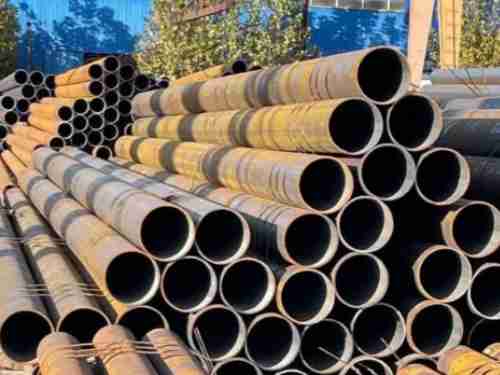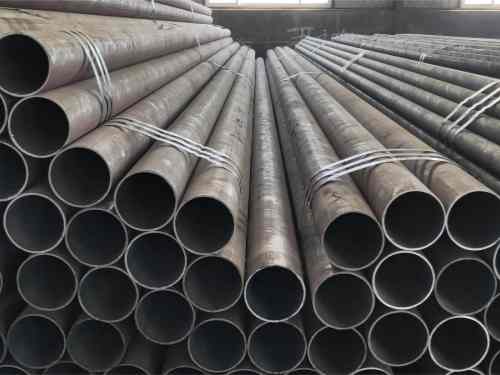Seamless carbon steel pipe is a high-performance steel pipe product known for its superior strength, pressure resistance, and weldability. It is an essential material across multiple industries, from oil and gas to power generation and mechanical manufacturing.
Material Composition and Standards of Seamless Carbon Steel Pipes
Seamless carbon steel pipe is primarily composed of iron (Fe) and carbon (C), with the carbon content typically ranging from 0.06% to 0.25%. The absence of weld seams gives it a uniform structure, ensuring high mechanical strength and excellent resistance to internal pressure.
Common standards include ASTM A106, ASTM A53, and EN 10216-1/2, which define strict requirements for its chemical composition, manufacturing process, and performance characteristics.
Key Features of Seamless Carbon Steel Pipes
High Pressure Resistance: The dense microstructure of seamless pipes allows them to perform reliably under high-pressure conditions.
Excellent Weldability: Carbon steel pipes can be easily joined with various welding techniques, ensuring strong and leak-free connections.
Outstanding Durability: With good crack resistance and mechanical stability, seamless carbon steel pipes deliver long-term reliability in harsh environments.
Service Life of Seamless Carbon Steel Pipe
The lifespan of seamless carbon steel pipes varies depending on operating conditions, material quality, and maintenance.
Under normal use and proper maintenance, service life ranges from 10 to 50 years.
In corrosive or high-temperature environments, life expectancy may decrease without adequate protection.
For non-coated carbon steel pipes, the typical service life is 10 to 15 years.
Overall, seamless carbon steel pipe combines strength, performance, and cost-effectiveness, making it a preferred choice for long-distance transmission pipelines, boiler systems, and structural applications where reliability and longevity are essential.
Typical Service Life Range of Seamless Carbon Steel Pipe
|
Environmental conditions
|
Estimated service life (without anti-corrosion)
|
Main failure form
|
|
Dry air (indoor)
|
10~15 years
|
Slow oxidation, surface rust
|
|
Ordinary humid atmosphere (outdoor)
|
5~10 years
|
Uniform rust, local pitting
|
|
Industrial polluted atmosphere
|
3~8 years
|
Acidic gas accelerates corrosion
|
|
Neutral water (pH=6~8)
|
2~5 years
|
Inner wall rust + microbial corrosion
|
|
Acidic/alkaline medium
|
1~3 years
|
Rapid chemical corrosion + perforation
|
|
Seawater/high salt environment
|
1~5 years
|
Electrochemical corrosion + pitting
|
Factors Affecting the Service Life of Seamless Carbon Steel Pipes
Seamless carbon steel pipe is widely used in oil and gas, petrochemical, power, and industrial piping systems due to its durability and strength. However, its actual service life depends on multiple external and internal factors that influence corrosion resistance, mechanical performance, and overall reliability.
- Operating Environment
The operating environment plays a decisive role in the service life of seamless carbon steel pipes.
In humid or corrosive conditions, steel surfaces are more likely to oxidize and degrade.
In the chemical industry, pipes must withstand corrosion from acids, alkalis, and solvents.
In the petroleum sector, they must endure extreme pressure, high temperature, and aggressive gases such as H₂S and CO₂.
- Pipe Quality
The quality of seamless carbon steel pipe directly determines its resistance to stress and corrosion.
High-quality pipes have superior strength and toughness, maintaining integrity under pressure.
Poor-quality pipes with impurities or air inclusions are more likely to crack, leak, or rupture during use.
- Pipeline Construction
Improper installation or substandard welding reduces the lifespan of seamless carbon steel pipelines.
Defective welds affect sealing and pressure capacity.
Incorrect pipe support spacing or excessive bending stress can cause fatigue failures.
Construction should comply with ASME B31.3 industrial piping standards, with hydrostatic and non-destructive testing (NDT) performed before commissioning.
- Maintenance Practices
Lack of preventive maintenance is one of the main reasons for early pipeline failure.
Regular inspection, cleaning, and corrosion monitoring can significantly extend service life.
Techniques such as ultrasonic thickness testing (UT) and corrosion rate analysis are recommended every 1–2 years to detect early deterioration.
- Media Properties
The chemical composition of the medium inside the pipe has a major influence on corrosion rate.
Acidic media (pH < 6) can accelerate metal loss by 0.2–0.5 mm/year.
Pipelines carrying H₂S or CO₂ require API 5L PSL2-grade materials or internal protective coatings.
- Temperature Fluctuations
Thermal expansion and contraction caused by temperature variations create stress and fatigue.
At temperatures above 400°C, creep and oxidation accelerate, reducing the long-term fatigue strength of carbon steel.
Measures to Extend the Service Life of Seamless Carbon Steel Pipes
- Choose High-Quality Materials
Always select pipes from reputable seamless carbon steel pipe manufacturers with ISO 9001 certification. Products should comply with ASTM, API, and EN standards to ensure stable performance under pressure and temperature extremes.
- Apply Anti-Corrosion Protection
Protective coatings are the most effective way to extend service life:
Internal coating: Fusion Bonded Epoxy (FBE)
External coating: 3-layer polyethylene (3PE) or polypropylene (3PP)
Other options: Hot-dip galvanizing or cathodic protection systems
These methods can increase service life by 3–5 times.
- Ensure Quality Construction
Follow all welding and installation specifications. After welding, perform RT/UT/PT tests to verify weld integrity and eliminate hidden defects before the pipeline is put into service.
- Strengthen Maintenance and Monitoring
Conduct regular cleaning and corrosion inspections.
Use intelligent monitoring systems such as corrosion sensors to track real-time conditions of long-term operating pipelines.
- Optimize the Operating Environment
Install pipelines in dry, well-ventilated areas when possible.
Where exposure is unavoidable, use protective layers, drainage systems, or ventilation to reduce environmental corrosion.
Conclusion
The service life of seamless carbon steel pipe depends on factors such as environment, medium, construction quality, and maintenance. Under optimal conditions, it typically lasts 10–50 years, and with advanced anti-corrosion protection or use in non-corrosive environments, it can exceed 50 years.
By combining high-quality materials, standardized construction, and scientific maintenance, industries can ensure the long-term safe and reliable performance of seamless carbon steel pipelines.

 English
English Español
Español











